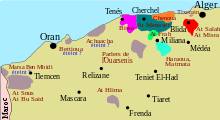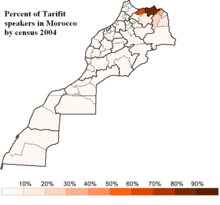Riffian language
The Riffian or Riffian Berber (native local name: Tmaziɣt or Tarifit; external name: Tarifit) is a Zenati Berber language. It is spoken natively by some 6 to 7 million Riffians of Morocco and Algeria, primarily in the Rif provinces of Al Hoceima, Nador, Driouch, Berkane and as a minority language in Tangier, Oujda, Tetouan and Larache, and in Melilla, in Spain. In addition, Riffian expatriate communities also speak the language.
| Riffian | |
|---|---|
| Tmaziɣt | |
| Native to | Morocco, Melilla (Spain), Algeria |
| Region | Rif |
| Ethnicity | Riffians |
Native speakers | 4,400,000 (2016)[1] |
Standard forms | Standard Moroccan Tamazight
|
| mainly Latin script | |
| Language codes | |
| ISO 639-3 | rif |
| Glottolog | tari1263[2] |
Classification
Riffian is a Zenati Berber language[3] which consists of various sub-dialects specific to each clan and of which a majority are spoken in the Rif region, a large mountainous area of Northern Morocco, and a minority spoken in the western part of neighbouring Algeria.
Geographic distribution
Riffian is spoken mainly in the Moroccan Rif on the Mediterranean coast and in the Rif mountains, with a large minority in the Spanish autonomous city of Melilla.[4] There are also speakers of Riffian in Morocco outside the Rif region, notably in the rest of Moroccan cities where they compose a minority. The neighbour state of Algeria is also home to Rif minorities. A Riffian-speaking community exists in the Netherlands and Belgium as well as to a lesser extent other European countries. Its own speakers simply call it "Tamazight", a term also often applied in a broader sense to the Berber language across North Africa in general.
Dialects
Dialects include West-Riffian (Al Hoceima), Central-Riffian (Nador) and East-Riffian (Berkan).
Iznasen (Iznacen, Beni Snassen) is counted as a dialect in Kossman (1999), but Blench (2006) classifies it as one of the closely related Mzab–Wargla languages.
Morocco
There is a large amount of dialectal variation in Riffian Berber; this can easily be seen using the dialect Atlas (Lafkioui, 1997), however Riffian compose a single language with its own phonetical innovations distinct from other Berber languages. Majority of them are spoken in Northern Morocco, this includes the varieties of Al Hoceima, Temsamane, Nador, Ikbadene (including Iznasen) and the more southernly variety in the Taza province. Besides Riffian, two other unrelated and smaller Berber languages are spoken in North Morocco : the Sanhaja de Srair and the Ghomara languages.
Algeria

A few Riffian dialects are or used to be in the western part of Algeria, notably by the Beni Snouss tribe of the Tlemcen, as well in Bethioua but also in various colonial districts Riffians started to emigrate to since the 19th century.
Sounds
Riffian's most noticeable differences from other Berber dialects are that:
- /l/ in other dialects corresponds to ⟨ř⟩ in Riffian (example: ul (heart) → uř )
- /ll/ (geminate /lː/) in other dialects corresponds to ⟨ǧǧ⟩ (/dː͡ʒ/) in Riffian (example: yelli (my daughter) → yeǧǧi ).
- /lt/ in other dialects corresponds to ⟨č⟩ (/t͡ʃ/) in Riffian (example: weltma (my sister) → wečma ).
These variations do not occur in the Riffian dialects of Ikebdanen and Iznasen.
| Riffian letter | Riffian word | The word in other Berber dialects | meaning in English |
|---|---|---|---|
| Ř ř | uř | ul | heart |
| aɣyuř | aɣyul | donkey | |
| awař | awal | speech / talk | |
| Ǧ ǧ | azeǧǧif / azedjif | azellif | head |
| yeǧǧa / yedja | yella | (he) is / (he) exists | |
| ajeǧǧid / Ajedjid | ajellid | king | |
| Č č | wečma | weltma | my sister |
| tacemřač | tacemlalt | blonde / white | |
| taɣyuč | taɣyult | female donkey (jenny) |
- postvocalic /r/ preceding a consonantal coda is dropped, as in taddart (house/home) → taddaat. Thus in tamara the /r/ is conserved because it precedes a vowel.
- Additionally, the initial masculine a- prefix is dropped in certain words, e.g., afus (hand) becomes fus, and afighar (snake) becomes fighar. This change, characteristic of Zenati Berber varieties, further distances Riffian from neighbouring dialects such as Atlas-Tamazight and Shilha.
- "Tarifit" or "Tarifiyt" is by some tribes pronounced as [Tharifesht].
Writing system
Like other Berber languages, Riffian has been written with several different systems over the years. Most recently (since 2003), Tifinagh has become official throughout Morocco. The Arabic script is not used anymore for writing Riffian Berber. The Berber Latin alphabet continues to be used unofficially online and in most publications in Morocco and abroad. However, unlike the nearby Tashelhit (Shilha), Riffian Berber has little written literature before the twentieth century.
References
- Riffian at Ethnologue (23nd ed., 2020)
- Hammarström, Harald; Forkel, Robert; Haspelmath, Martin, eds. (2017). "Tarifiyt-Beni-Iznasen-Eastern Middle Atlas Berber". Glottolog 3.0. Jena, Germany: Max Planck Institute for the Science of Human History.
- Riffian language at Ethnologue (18th ed., 2015)
- "CpM moción regular Tamazight Melilla tomando ejemplo Bable Asturias". Web.archive.org. 2010-04-14. Archived from the original on 2010-04-14. Retrieved 2017-03-07.CS1 maint: BOT: original-url status unknown (link)
Sources
- Biarnay, Samuel. 1911. Etude sur le dialecte des Bet't'ioua du Vieil-Arzeu. Alger: Carbonel.
- Biarnay, Samuel. 1917. Etude sur les dialectes berbères du Rif. Paris: Leroux.
- Cadi, Kaddour. 1987. Système verbal rifain. Forme et sens. Paris: Peeters.
- Colin, Georges Séraphin. 1929. "Le parler berbère des Gmara." Hespéris 9: 43-58.
- Kossmann, Maarten. 2000. Esquisse grammaticale du rifain oriental. Paris: Peeters.
- Lafkioui, Mena. 2007. Atlas linguistique des variétés berbères du Rif. Köln: Rüdiger Köppe.
- McClelland, Clive. The Interrelations of Syntax, Narrative Structure, and Prosody in a Berber Language (Studies in Linguistics and Semiotics, V. 8). Lewiston, NY: Edwin Mellen Press, 2000. (ISBN 0-7734-7740-3)*Renisio, A. 1932. Etude sur les dialectes berbères des Beni Iznassen, du Rif et des Senhaja de Sraïr. Paris: Leroux.
External links
| Riffian language test of Wikipedia at Wikimedia Incubator |
- Tarifiyt Berber Vocabulary List (from the World Loanword Database)
- INALCO report on Tarifit (fr)
